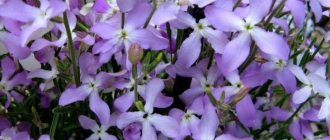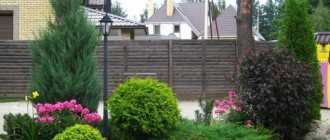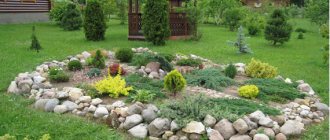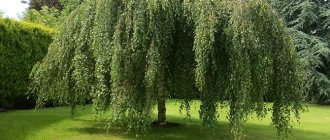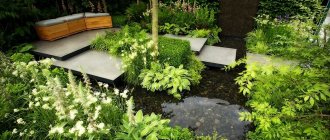Review author: Terra Design School
To transform their plots, gardeners have increasingly begun to use vertical gardening in the form of flowering and decorative deciduous vines. Climbing plants are original, practical and decorative.
Planting vines in a garden plot will allow:
- hide defects on the walls of outbuildings or a country house;
- create cozy areas on the site;
- make an elegant design of the fence around the site;
- decorate the gazebo with flowers and greenery.
With the help of vines you can create landscaping and decorate the area in a vertical direction. Lianas are able to create a certain microclimate in a separate area of the site, conducive to growing capricious plants or flowers around them, attracting insects for pollination. There are types of vines that bear fruits suitable for human consumption.
The photo shows popular types of vines for the garden.
Perennial vines with decorative leaves
To choose climbing perennials, you should know that they are divided into several types: creeping (for landscaping horizontal areas), climbing (with suckers on the stems) and clinging to supports.
If you want to create a hedge, then choose perennial climbing plants with decorative carved leaves or leaves of an unusual, bizarre shape.
Typically, these crops are not afraid of frost, drought-resistant, and do not require special care. Most often they are used for landscaping a fence, especially if the fence spoils the appearance of the site, as well as any garden and outbuildings.
Amur grapes
Amur grape is an unpretentious plant; if planted near a fence or unsightly outbuilding, it will quickly fill the space and decorate the object. The length of an adult grape is 20 meters.
From its name we can conclude that the plant is not afraid of frost. Indeed, Amur grapes have the highest frost resistance among grape species.
The plant appeared before the Ice Age, and then successfully took root in harsh conditions, so it is not afraid of any frost.
By planting a vine along the fence, you will soon have a magnificent hedge, and even enjoy delicious fruits. This grape variety can be safely shaped as you wish; it is not afraid of pruning. Even after shearing, it will be strewn with bunches of berries.
Euonymus rotundifolia
One of the most beautiful climbing plants can be called rotundifolia. The liana can be used to decorate high fences, pergolas, gazebos, and trellises. The bush quickly climbs to any height using flexible lashes.
But wood pliers are dangerous to other plants. They can destroy any tree by tightly hugging its trunk and digging their lashes deeply into it. In his strong embrace, other trees simply die. This destroyer should not be allowed to be near a tree of any kind.
Wood pliers are unpretentious and can grow in any place, creating beautiful pictures without requiring any care. You just need to plant it somewhere separately.
Actinidia
If you have a shaded fence or wall of a house where little light penetrates, then plant actinidia. She doesn't like to be in the sun. To create original vertical compositions in the garden, actinidia is also best suited.
It can grow on any soil. And not just to grow, but to annually present the owners with delicious oblong fruits. Breeders have developed many varieties of actinidia that produce good harvests. The most generous harvest varieties are: Soroka, Prazdnichny, Slastena, Lakomka.
The fruits of this plant, similar to kiwi, are endowed with many useful vitamins and microelements.
Maiden grapes
Another type of grape is girlish grape. It will grow well wherever you find a place for it, the main thing is to prune it in a timely manner. It can take a liking to arches, walls, fences, or occupy the entire free surface of the dacha.
With its help, it is easy to landscape the most unsightly area in the garden. It is unpretentious and grows very quickly, which is what attracts gardeners.
Honeysuckle Kamchatka
Kamchatka honeysuckle is more capricious than other plants that are planted as a hedge. She does not like drafts and shaded places. Kamchatka honeysuckle bushes should be planted in sunny areas, regularly watered and fertilized.
It is valuable that this shrub is not afraid of frost and produces tasty fruits rich in vitamins C, B, P and microelements beneficial to humans.
garden ivy
Another beautiful plant that can decorate any structure is garden ivy.
If you need to cover the gazebo with a green carpet, then ivy is the most convenient plant. One of the most unpretentious climbing plants is ivy. It can grow up to 30 meters in height, so it can entwine even the highest supports.
For gazebos and pergolas, this is not only a decoration, but also a way to create a romantic, private place in the garden.
Planting should be carried out with seedlings 2-3 years old. They are planted in spring in shallow holes with organic fertilizer. In summer it must be trimmed to any shape. But before winter frosts, the ivy roots must be covered with earth, leaves, and then with a special coating.
Garden ivy is easy to care for, but prefers fertilized soil, so from time to time it needs to be fertilized, as well as watered and pruned.
Kirkazon largeleaf
Kirkazon largeleaf is capable of creating an amazing picture - neatly laid tiles. This plant can grow in any soil, but is very afraid of drafts. It is worth noting its picturesque appearance and high frost resistance.
Any arch, pergola, gazebo can be decorated with a picturesque steeplejack, and a green tunnel can be created. Flowers of unusual shape and outlandish color are striking, as well as its miraculous medicinal properties, which are widely used in folk medicine.
Clematis
The plant is a herbaceous perennial with a rather capricious character. It loves plenty of water and a sunny place.
To increase the duration of flowering, it is necessary to promptly remove dead buds. In autumn, clematis should be pruned, leaving only a few of the strongest shoots.
Deciduous perennial vines for hedges
The variety of climbing flowering vines that are used to decorate fences and unsightly areas in the country is amazing. Abundantly flowering plants for a fence can turn it into a picturesque picture.
Climbing plants are good because they grow in one place for several years. In order not to place a support near them, plant flowering vines near the fence, around the gazebos.
Here are fast-growing climbing plants for fences, arbors and arches.
Clematis
Climbing flowers called “clematis” are one of the most beloved plants among gardeners. What did they do to deserve such a position? Clematis grows quickly, blooms beautifully throughout the summer, and is not too capricious.
Before planting climbing clematis on the site, you should choose a variety. The thing is that each variety has flowers that differ in shape and color.
Bizarre flowers can be in the form of an open bowl, a wilted bell, or an unopened jug. The most favorite are the varieties where the plants bloom with purple flowers.
climbing roses
The leader among crops for decorating arches, fences, gazebos, and pergolas are gorgeous climbing roses. The climbing rose has many advantages:
- It is unpretentious;
- A huge number of flowering varieties have been developed;
- It grows very quickly and lives in one place for a long time;
- There are varieties that can bloom 2 times during the summer.
Climbing roses can entwine any support and decorate the area. In order for roses to bloom profusely, they must be periodically watered and fed with complex fertilizers.
Climbing plants immediately attract attention, and anyone who sees a flowering fence or a gazebo entwined with flowers will definitely wish to have such beauty in their dacha.
Kampsis
These perennial climbing flowers are characterized by very fast growth, which has earned them the love of gardeners.
Campsis is the most unpretentious plant, with unusual flowers. The orange flowers look like inverted tubes.
Its only drawback: it needs to be covered for the winter if frosts exceed minus 18 degrees.
Cover it with spruce branches, dry leaves, and then with covering material or burlap. There is no need to cover them with plastic wrap; they will die under it.
Wisteria
Wisteria is an unusually luxurious plant that can decorate gazebos and all small architectural garden forms. It is memorable for its lush clusters of lilac flowers, which bloom so luxuriantly that they cover all the greenery. The inflorescences reach a length of 50 cm in length, which amazes at first sight.
The plant loves warmth, so it requires shelter for the winter so that the shoots do not freeze. If the shoots freeze, then in the spring the vine may produce new branches. But it will not bloom, because buds form only on last year’s shoots.
Sweet pea
Liana is unpretentious. Low-growing varieties are used to decorate beds, while tall varieties are used to create vertical compositions.
It is distinguished by fragrant flowers, for which it acquired its name. Ornamental plants are planted in the ground in mid-spring; you can use seedlings, so the vine will grow faster.
Blooming perennial vines
Schisandra chinensis
Chinese lemongrass can surprise you with its beauty and taste of its berries. This climbing plant retains its decorative value even in autumn, thanks to the blazing red fruits.
When planting this plant in the garden, you need to take care of support. The vine will wrap around the support and climb up. When lemongrass blooms with white flowers, a pleasant aroma will hover around the vine. It is noteworthy that the flowers will gradually acquire a pink tint during flowering.
What care does this plant require? To get bunches of beautiful berries in the fall, you need to water it, trim off excess branches and mulch the soil around the roots.
Schisandra can grow up to 10 -15 meters, but in the regions of Russia it grows no more than 4 meters. You can plant several seedlings, providing them with support. You will get a beautiful flowering fence, which by autumn will be covered with red berries.
Hydrangea climbing
The flowering vine can be used as a fence and for landscaping facades and fences. But many gardeners plant hydrangea to decorate a free plot of land in their country house.
Climbing hydrangea can become a ground cover plant and cover a flowering carpet, for example, the tree trunk under an apple tree.
Most often, climbing hydrangea is planted against a solid wall, where it climbs to the very top, blooming snow-white flowers. The plant is quite unpretentious. In dry summers it requires watering and fertilizing in the fall.
Wild grapes
Wild grapes can decorate the facade of a house. Clinging to rough walls with its antennae, it can climb all the way to the roof.
Grows on any soil. By planting several cuttings around the house, in a couple of years you will get a lush wall decoration. In the third year, the grapes will bloom and bear fruit, but require timely pruning.
Advantages of wild grapes:
- Grows quickly, aesthetically pleasing;
- Winter-hardy, does not require shelter for the winter;
- Not afraid of pests, does not require much feeding;
- The bushes of the plant are capable of pumping out excess moisture from the ground. By planting virgin grapes near the house, you can drain the cellar of water;
- By decorating a street fence, you will get a chic hedge and protection from prying eyes;
- Suitable for landscaping gazebos. Dense growth creates coolness and shade;
- In autumn, the vine foliage takes on a pleasant purple hue.
Wild grapes also have disadvantages. The most important of them is that in winter the wall of a house covered with dry branches will not look at all aesthetically pleasing. You should not plant it very close to the wall of the house, as it produces strong roots that can penetrate under the wall.
Honeysuckle Honeysuckle
This fragrant, spectacular vine loves the sun, but can also tolerate partial shade. It reaches its maximum size after 5-6 years of life.
Honeysuckle honeysuckle is not picky about soil acidity, but prefers areas with fertile, well-drained soil. Liana can withstand frosts down to –25°C. Propagated by cuttings, seeds and layering.
Honeysuckle honeysuckle is one of the most traditional vines for pergolas and gazebos. During flowering, it attracts a huge number of butterflies and bees and fills the garden with a pleasant aroma.
| Vine length (m) | Flowering time | Soil type | Peculiarities |
| 4-8 | Late May – mid July | Fertile, moist, loose | For good flowering, formative pruning is required in March-April. |
Annual loaches
Not all gardeners prefer perennial plantings of climbing plants. Many people want to have a different picturesque picture on their site every year.
Climbing annuals have the following advantages:
- Easily propagated by seeds, grows quickly;
- Savings on purchasing seedlings;
- You can create many options when creating a landscape design by choosing different varieties of vines.
You won’t get bored with climbing annuals, because every year you can plant different varieties that will delight you with flowers of all shades and shapes.
morning glory
Morning glory is very similar to the well-known bindweed, but unlike ordinary bindweed, it can grow up to 5 meters. The leaves of the plant can be heart-shaped or openwork. Flowers can also come in a variety of colors.
Morning glory flowers, opening with the sunrise, turn after it. For this ability, morning glory has another name - “flower of dawn”. In dry summers it requires watering.
China latifolia
Latifolia is a member of the Legume family. It is sometimes confused with sweet pea, although it itself does not boast a strong aroma. However, chin is also called broadleaf pea.
This herbaceous plant can reach 4 m in length, clinging to the surface with tendrils. Chyna reproduces well by seeds, withstands frosts down to –29°C, and loves good lighting. The color scheme of large, showy chin flowers is white, pink, red-violet.
| Vine length (m) | Flowering time | Soil type | Peculiarities |
| 1,8-4 | June August | Sandy, sandy loam, loamy, limestone | Reacts poorly to transplantation in adulthood, best propagated by seeds |
Shade-loving loaches
Not all summer residents have areas completely flooded with sun. There are places in the shade that you also want to decorate with beautiful flowers.
Aristolochia (kirkazon)
A plant with large leaves and original flowers looks very beautiful when it entwines coniferous trees. Against the background of dark spruce trees, Aristolochia stands out unusually beautifully.
If the hedge is made of coniferous trees, then in some places a solid coniferous wall can be diluted with aristolochia.
Prince
Prince is a close relative of clematis, but is not at all demanding of care. The flower is interesting because it blooms very early. Its large white, blue or purple flowers will decorate any support.
It quickly entwines the wall with jagged edges of leaves and rises up, creating a very beautiful picture.
Ivy
Considered an evergreen plant, it does not lose its leaves during the winter. A new green outfit sprouts in the spring as the old leaves fall.
Ivy is a rather finicky plant; it can burn in the sun or freeze in the cold season. Therefore, for planting it is necessary to choose a shaded place and wrap it up for the winter.
Evergreen climbing plants
To decorate the landscape of their garden, gardeners plant evergreen climbing plants. This is beautiful and practical, because the plant remains green even in cold weather.
Snow-white evergreen honeysuckle
Snow-white evergreen honeysuckle can grow up to 6 meters in height. Due to its high growth, it is very suitable for creating a high vertical hedge. You can’t pass by the picturesque fence without admiration.
She loves to be looked after, regularly watered with warm water and fertilized. Honeysuckle will respond with beautiful flowering.
Passionflower
The evergreen liana surprises with large exotic flowers with a delicate aroma. Depending on the species, star-shaped flowers can be white, blue, purple or red.
Passionflower blooms only for a day, releasing an endless number of buds. Some plant species produce edible fruits—passion fruit.
Kobeya climbing
The tall plant can rise to a height of 10 meters over the summer. Kobeya will perfectly braid fences, fences, arches; Large bells will give the support a nice look.
Loves sunny places and moist air, grown using seeds, which are immediately planted in the ground.
Fast growing climbing plants
Every gardener wants to quickly decorate a garden plot or transform a fence, rather than wait years for a dense hedge to appear. To do this, you need to choose those plants that grow quickly.
Bougainvillea
This perennial loach came to us from Brazil. Breeders have received a large number of varieties to suit every taste.
Bougainvillea grows well in full sun and prefers regular watering. But he doesn’t like the cold; even at minus 5 degrees he can die.
In order for the vine to survive, it is removed in a warm room in the fall.
This plant should not be chosen to decorate a fence. To create a semblance of a hedge, you can place tubs with this plant near the fence. In tubs it is easier to put it away in a warm room for the winter.
Spiraea meadowsweet
Spiraea meadowsweet is a fast-growing shrub that will decorate any corner of the garden. It grows quickly and blooms very beautifully. But he loves good care. In dry summers it is necessary to water and feed frequently.
morning glory
Usually such a vine is called bindweed. With good care, bindweed will grow up to 10 meters; it loves shady places and plenty of moisture. Able to reproduce by self-sowing.
The ideal time for planting is spring. Bindweed is completely unpretentious, but will delight its owners with lush flowering. Currently, there are numerous colors, although the most popular is morning glory in blue shades.
Selection and features of landing
To plant climbing plants, you need to know their flowering range. A hedge will look beautiful if some vines fade and others come to replace them. With this planting, from early spring to late autumn, you will have a bright environment of flowers.
Planting close to the walls of houses and other buildings is not recommended. It is necessary to retreat 30 cm from the place of support so that the roots of the seedlings have a sufficient amount of soil for strengthening.
Before planting, you need to add into the hole the fertilizer that this particular plant needs. Do not plant plants too densely, as this will prevent you from creating a beautiful hedge. The plants will be cramped.
The gap between seedlings should be 1.5-2 meters so that each vine receives enough light, air, nutrition and moisture.
Wild grapes
A completely unpretentious plant that can quickly create an unusual look thanks to its carved leaves. The first greenery appears in the second half of April; in the fall, the color of the foliage changes to dark green, red, burgundy, which makes the hedge multi-colored and unusual.
It will grow great in partial shade and in open areas.
garden grapes
This vine will require a little more care. It must be pruned throughout the season, wrapped for the winter, and ensure proper branching.
Wooden trellises are the best option, but horizontally stretched ropes can be used. Water the grapes as needed, making sure that the roots do not rot.
But the efforts of the owners will be rewarded in the fall with a delicious harvest of healthy berries.
Schisandra
Another useful ornamental plant.
Its fruits are used for medicinal purposes, made into preparations or simply frozen. You can also use leaves, branches, and roots of lemongrass. Liana prefers sun and abundant watering. It is necessary to monitor the vertical growth of the lashes, since in this case pollination will occur much better.
It is recommended to cover lemongrass for the winter.
Wisteria
Most of all, wisteria react not to the composition of the soil, but to climatic conditions and location. The site must be protected from the wind, the soil must be free from the slightest accumulation of water and the presence of lime. Otherwise, this will lead to the death of the plant. Wisteria grows very strongly, so that the powerful branches do not break under their weight; reliable support is necessary, which is why it is most often used to decorate pergolas. Pruning of the crop is carried out twice a year - this stimulates the growth of new buds and, as a result, lush flowering.
- In spring - shortening old shoots and side branches by 30-40 cm;
- In autumn, young shoots are cut to 4-5 buds.
Trimming
All vines grow beautifully. And if for annuals there is no crime in this, then for perennials it will be necessary to limit growth by pruning. This will help form a nice crown and provide nearby growing plants with light, warmth and nutrients.
Most often, pruning is carried out in the fall. In some cases, when the vines are very neglected, such an event can be held in early spring.
When pruning, old, damaged, diseased branches are removed. For fruit-bearing vines (grapes, lemongrass), only five or six good shoots are left; all the rest, along with young shoots, are destroyed.
Actinidia
This climbing vine is also called frost-resistant kiwi, but if you plan to get useful fruits from it, you will have to plant seedlings of different sexes. A tree-like vine needs reliable support, which can be a tree or hedge growing nearby. When growing, follow the basic rules.
- Location – south side of the site;
- The soil is slightly acidic or rich loam;
- Fertilizer - loves mineral fertilizers and organic matter;
- Pruning – formative and sanitary in the spring.
Roses
Curly pink vines will decorate any garden if they are properly cared for. The plant requires pruning, feeding, and protection from the cold. But in return it will give you amazing beauty and a delicate aroma.
Photos of vines for the garden show all the beauty of climbing plants and make you want to immediately purchase the same miracle.
